Glass Mansions
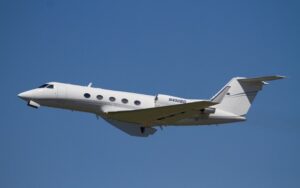
On its final approach to the Winnipeg Airport, Safeway’s company jet glided through the air smoothly, as always. I sat in a plush leather bucket-seat facing forward. The CEO sat across the aisle to my left. A Senior Vice President sat directly behind the cockpit, facing us. The cockpit door was open with a curtain drawn across it. We couldn’t see the pilot and co-pilot, but we heard the drone of their conversation with air traffic control.
The three of us from Safeway were chatting amiably when something hit us mid-air. There was a loud thud; the plane shuddered; and the pilot screamed.
I flinched and clenched the arms of my chair. The executive facing me looked like she’d been punched in the gut, and the CEO let out a muffled cry. The plane dipped forward. The engines sputtered, skipped a few beats, then caught hold again, and the jet leveled off, resuming its gradual descent. The entire incident consumed only a few seconds, just long enough for my life to pass before me.
“Everything all right?” the CEO said to the cockpit, his voice shaking.
“We’re good,” the co-pilot said.
“Valerie?” the CEO said.
“Sorry for the outburst.” Her voice was calm, reassuring. “We hit a goose. Bloody mess on Greg’s windshield, but we’re fine. We’ll touch down safely in a few moments.”
The CEO didn’t look convinced. I wasn’t either, but the pilot was true to her word. In less than a minute, we were coasting to the terminal.
 Standing on the tarmac, I looked up at the face of the jet. A basketball-sized gash dented the nosecone. Blood, entrails, and feathers covered the co-pilot’s windshield. Winnipeg is the capital of Manitoba, the Canadian province known as the land of a hundred thousand lakes. Thousands of geese flock to the lakes in the summer and pose a flight risk to aircraft on approach to the airport. The pilot said we were lucky. On one of her flights, a goose blew out the windshield and splattered innards all over the cockpit.
Standing on the tarmac, I looked up at the face of the jet. A basketball-sized gash dented the nosecone. Blood, entrails, and feathers covered the co-pilot’s windshield. Winnipeg is the capital of Manitoba, the Canadian province known as the land of a hundred thousand lakes. Thousands of geese flock to the lakes in the summer and pose a flight risk to aircraft on approach to the airport. The pilot said we were lucky. On one of her flights, a goose blew out the windshield and splattered innards all over the cockpit.
Practicing law and serving as a Safeway executive, I was a passenger on scores of private jet flights. Other than the goose collision, they were all serious mood-enhancers. No crowds to fight. No lines. A car drives you right up to the plane. It takes off when you’re ready. The cabins are spacious, luxurious, and comfortable. A steward serves Cabernet Sauvignon in crystal glassware and gourmet meals on fine china.
I’ve also flown more than three hundred commercial flights. When I worked at Safeway, I flew on Southwest Airlines cattle cars so often Southwest named me Burbank Airport passenger of the year three years in a row. All Southwest seats are coach class with passengers packed in like sardines. No reserved seating; first come, first served. More often than not, I was trapped in a middle seat, including an unforgettable adventure sitting between a three hundred pound guy spilling over my armrest and a young mother with a screaming baby in her lap. No gourmet meals on Southwest. I was lucky to get a Diet Coke in a plastic cup, and if the flight attendant liked me, two bags of fifteen peanuts each instead of the standard one bag per passenger. Given a choice, any sane person would choose to fly on a private jet rather than a Southwest 737 or any other commercial plane.
Unless that person is concerned about CO2 emissions. Private jets are big-time polluters on a passenger per capita basis. Because of the low passenger load, a private jet passenger generates somewhere between twenty and forty times the carbon emissions of a commercial passenger.
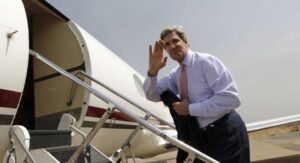
Based on that data, you would expect environmentalists to scream to high heaven for the abolition of private jet travel. There are some loud voices coming from lesser-known advocates, but most high-profile climate change reformers are wealthy private jet frequent-fliers. Living in glass mansions, they don’t throw stones.
President Biden’s climate czar, John Kerry, recently flew to Iceland on a private jet to accept an award for his work on climate change. The irony of his transportation mode was lost on him. “(I)t’s the only choice for somebody like me who is traveling the world to win this battle,” he said. “I believe, the time it takes me to get somewhere, I can’t sail across the ocean. I have to fly, meet with people, and get things done.” His explanation tellingly ignores commercial flights, as though that option doesn’t exist for “somebody like me.”
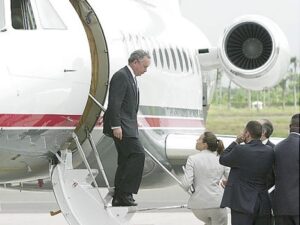
The United Nations recently reappointed Michael Bloomberg as its climate envoy. Bloomberg will fulfill his duties by traveling the world on his fleet of private jets. He does not see this as inconsistent with climate change reform. As a Bloomberg publication explains, “For many people, private jets seem like an extravagance. But for busy executives and celebrities, the time savings, convenience, and extra security they offer make them more of a necessity.” From 2016 to 2020, Bloomberg flew more than 1,700 such necessary flights, emitting more than 10,000 tons of carbon.
Bill Gates funds many worthy clean energy projects. He owns four jets, which he refers to as his “guilty pleasure.” In 2017, they spewed more than 1600 tons of carbon into the atmosphere.
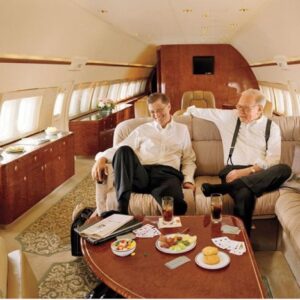
In 2019, the world’s A‑list of climate change luminaries flew 114 private jets to Italy to attend a summit on global warming organized by Google. Google executives own ten private jets, two Boeing airliners, and a fighter jet.
Some wealthy climate change advocates claim they offset private jet emissions by purchasing carbon credits. A Bloomberg article suggests convenient ways to do this. “You can offset a ton of CO2 by donating $18 to a reforestation effort in East Timor or by giving $15 to a program that provides fuel-efficient stoves for women in North Darfur.”
The accounting looks fishy, but even if it’s correct, you’d need to stack stoves ten high in every needy North Darfur kitchen to offset Bloomberg’s emissions alone. Besides, you would expect committed environmentalists to advocate accomplishing both goals simultaneously – funding the reduction of carbon emissions in poor nations while also greatly reducing air travel pollution by flying commercial. And yet, in researching this post, I found no wealthy environmentalist who set such an example.

This is not because flying private is a necessity for busy executives and celebrities, as Kerry and Bloomberg suggest. At Safeway, executives flew commercial before the company purchased the Gulfstream. It took more time; sometimes we had to bring along security personnel; and it was difficult to match our travel demands with commercial flight schedules. But we managed to work around the disadvantages and still achieve our goals.
Flying private is a willful choice based on convenience and comfort. Busy executives, celebrities, and wealthy environmentalists don’t want to fight their way through crowded airports, suffer indefinitely delayed take-offs, sit on planes with three hundred pound guys and screaming babies, miss connecting flights, and lose their luggage.
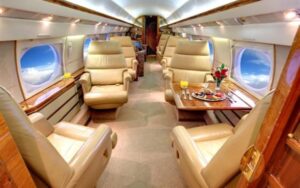
As someone who has flown too many miles on commercial flights, I get that. What I don’t get is the wealthy environmentalists’ presumption that they can lead the charge against global warming from a private jet’s plush leather seat while sipping Cabernet Sauvignon. Apparently, they think they can persuade the masses to make painful lifestyle changes while refusing to forego a luxurious “guilty pleasure” that produces carbon footprints thousands of times greater than that of the average person.
I don’t think so.
“Lead by example” is a time-worn maxim for a reason. If they want to change the world, park the jets.
Post Script: As Southwest Airlines Burbank Airport Passenger of the Year, my major award was a free Southwest flight to Chicago to an open-bar party. I couldn’t face yet another commercial flight even for free booze. I declined all three years.



July 25, 2021 @ 3:38 pm
Hi, Ken! As always, I loved your account of your ‘infamous’ flight! It was eye-opening, to say the least. I agree with you wholeheartedly, and I wish there were no ‘privileged’, just people, everyday people. Maybe then we could all work together to solve the world’s issues! Continue on, sir! P.s. I hope to never ride in a plane again!
July 26, 2021 @ 11:02 am
Thanks, Marcie! We need some leadership and much more unity. I haven’t been on a plane in three years. Like you, I’m not planning to board one again any time soon.
July 3, 2021 @ 11:26 pm
Ken, you are just a step or two ahead of the times with your thinking. I visited Germany on an extended stay in 2019, before the pandemic. Being a foreigner, people I met were always eager to know my opinion on matters close to their heart. In Germany, the environment is probably top of the list. It was the first time that I heard ordinary people condemning their fellow citizens for taking planes across Europe to go on holiday. Some even went so far as to say that they don’t want to see a plane in the sky.
Well, with the pandemic that followed on the heels of my return to South Africa, they nearly had their wish fulfilled. I have to smile when I remember those conversations. None of us could have predicted how suddenly and dramatically the world would change.
I think fewer people will be traveling by plane in future. We are learning by necessity to explore the beautiful spots around us instead of jetting off to foreign lands.
Also, companies are finally figuring out that you don’t need to be in the same room to have a meeting or work together. I believe that a lot of business travel in the past was unnecessary. Now is the time to shame those executives with the expensive toy planes until they give them up.
There will always be a need for commercial flights, and there will always be emergencies when a small jet is the most practical solution, but we should all consider the alternatives.
Have you done any research into the number of cargo planes flying around the world? That’s another thing that bothers me. With more efficient harbors and customs processes for shipping containers, a lot of cargo can be diverted to ships without a detrimental effect on the world economy. Many countries can improve their rail system to transport cargo instead of trucks on the road and cargo planes; South Africa is one of them.
I think the bottom line is that we are addicted to speed and convenience, and that we have neglected environmentally beneficial alternatives for much too long.
July 6, 2021 @ 7:58 am
Hi Megan. Thanks for your thoughts. You’re probably right about the lasting effects of the pandemic on flight travel, zoom conferences, and the like. Working from home looks like it’s here to stay in a big way, too, which will cut down auto pollution from commutes. I hadn’t thought about the cargo plane issue and haven’t researched it, but you’re probably right that less polluting alternatives have been ignored. My reason for targeting private jet travel is that it seems like low hanging fruit among climate change adjustments. There is a widely available, much less carbon spewing alternative in commercial flights and private flights are rarely justified by anything other than comfort and convenience. The other reason I focused on it is that so many environmentalists fly private all the time, although it is virtually indefensible given their climate goals and it destroys their credibility on the topic. It will be interesting to see if the major shifts in public travel habits remain in place after the pandemic lets go of us, as you predict. Thanks again for following my blog and reading my books.
June 26, 2021 @ 8:04 pm
Ah Pamela stole my word, I was going to talk about the hypocrisy of it all. I probably still will on FB. You have no idea how close this hits home to me regarding my beliefs about intelligent approaches to protecting the planet and carrying for all living things on it. I wont go off on your string. Just say thank you, this was wonderful
June 27, 2021 @ 8:13 am
Thanks, Eric. Your agreement encourages me that maybe I got it right.
June 26, 2021 @ 8:47 am
As the unnamed Female SVP sitting across from you on that fateful trip I have to say your recollection was spot on. I also agree with 100% of what you wrote. And BTW, we need more “preachers” just like you, Ken!
June 26, 2021 @ 11:46 am
Ha ha! Hey, Larree, it’s great to hear from you. You weren’t as shook up as I was, as I recall. I was looking around frantically for the parachute I hoped they carried on private jets! I’m glad you agree with the post. In researching this, I learned the average passenger count on private jets is 3.2. Based on the way ours was used, I was surprised it was that high. 🙂
June 25, 2021 @ 6:36 pm
Good information!
June 26, 2021 @ 7:36 am
Thanks, Rebecca.
June 25, 2021 @ 5:24 pm
Excellent points!!
June 26, 2021 @ 7:35 am
Thanks, Colleen.
June 25, 2021 @ 3:28 pm
Scary. Informative. Entertaining. And right on point about private jets. Lead by example.
Thanks, Ken.
June 25, 2021 @ 5:16 pm
Thanks, Lucian.
June 25, 2021 @ 3:05 pm
Ken, I enjoyed this piece. It caused me to recall a trip you, the Safeway CEO and I made to Denver in 1992( or maybe early 1993) to discuss “gain sharing “ with the team there. You and the CEO were booked in first class- I booked my ticket in coach as I always did. In fact, at that time in my life I had never ridden in first class. When the three of us arrived at the Oakland airport that morning, we were busy making final changes to the planned meeting we would have later in Denver. As we started to board the plane, the CEO suggested we finish our discussion after we were seated in the plane. You and the CEO boarded and took your seats in first class. I smiled as I passed you guys and took my seat in coach — near the back of the plane. When we landed the CEO asked why was I in coach. I explained I always flew coach. The CEO then realized he had just discovered another one of his soon to be famous cost savings ideas — No more first class travel for Safeway executives.
Then 2–3 years later, the first jet was purchased, those traveling on the company jet enjoyed the luxurious comforts of the Gulfstream. Those not on the corporate jet(s) enjoyed many of those 15ct peanuts, a Diet Coke in a plastic cup, 400lb traveling companions and an occasional sign along on SWA. It was a good life and I am forever grateful for my 41 year stint at Safeway when it was a great place to work.
I pray our country survives the wasteful, endless frivolous spending of our elected officials who lost touch with reality ( if they ever had it) shortly after being sworn in.
All the best!
June 25, 2021 @ 5:14 pm
Thanks, Steve. I remember that flight. We issued that coach class policy because of it. I liked that approach. I was against purchasing the corporate jet. I didn’t see how we could fly around to the divisions in it and preach cost-cutting at the same time. My objections fell on deaf ears and that jet wracked up a ton of mileage. I still think it was the wrong move for the same reasons expressed in this piece. It was a great place to work, though, and I ended up on one heck of a lot of commercial flights anyway, which was okay with me. Glad I got the chance to work with you and so many great people there. Thanks for following my blog.
June 25, 2021 @ 2:29 pm
Agree completely, but their argument is at least consistent with many aspects of their (and thus our) lives….”okay for me, but not for thee”.
June 25, 2021 @ 5:06 pm
True. Leading by example seems to be lost on this crowd.
June 25, 2021 @ 12:03 pm
Love this! So true. Lead by example.
June 25, 2021 @ 1:04 pm
Thanks, Alice!
June 25, 2021 @ 11:55 am
Agree 1,000%!!!!
June 25, 2021 @ 1:03 pm
Thanks, Lori! Glad to hear from you.
June 25, 2021 @ 11:25 am
Ken, I fully agree with your thoughts. The pure BS that most of these “privileged” spew out as to their mode of travel is sickening. Keep up the good work.
June 25, 2021 @ 1:03 pm
Thanks, Jim!
June 25, 2021 @ 11:11 am
Thanks for writing this. Ridiculous hypocrisy.
June 25, 2021 @ 1:02 pm
Thanks, Pamela. Lots of hypocrisy on every issue these days, it seems.